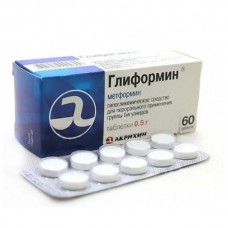Expiration date: 08/2025
Composition
1 tablet contains Metformin, 0.5, 0.85 and 1 g,
excipients: sorbitol, calcium phosphate dihydrate, polyvinylpyrrolidone (povidone), polyethylene glycol (macrogol), calcium stearate or stearic acid.
Packaging
60 PCs.
Pharmacological action
Gliformin inhibits hepatic gluconeogenesis, reduces glucose absorption from the intestines, enhances peripheral glucose utilization and increases the sensitivity of tissues to insulin. When this has no effect on insulin secretion from the beta cells of the pancreas. Lowers triglycerides and low-density lipoprotein in the blood. Stabilizes or reduces body weight. Provides fibrinoliticescoe effects by suppressing the inhibitor of plasminogen activator of tissue type.
Testimony
Diabetes mellitus type 2 (especially in patients suffering from obesity) when poor diet.
Contraindications
- diabetic ketoacidosis, diabetic precoma, coma,
- expressed violations kidney functions,
- cardiac and respiratory failure, the acute phase of myocardial infarction, acute violation of cerebral circulation, dehydration, chronic alcoholism, and other conditions that may contribute to lactic acidosis,
- pregnancy and breastfeeding,
- hypersensitivity to the drug,
- major surgery or trauma, when is shown holding insulin,
- the liver dysfunction, acute alcohol poisoning,
- lactic acidosis (including history),
- application for at least 2 days before and for 2 days after the radioisotope or radiological examinations with administration of iodinated contrast agents,
- adherence to a reduced-calorie diet (less than 1000 cal/day).
- It is not recommended to use the drug in patients older than 60 years, performing heavy physical work that is associated with an increased risk of development of lactic acidosis.
Method of application and doses
The dose is determined by physician individually depending on the level of glucose in the blood.
The initial dose is 0.5-1 g/day. 10-15 days there might be a further gradual increase in dose depending on the blood glucose levels. Maintenance dose is usually 1.5-2 g/day. Maximum dose 3 g/day. To reduce the side effects from the gastrointestinal tract, the daily dose should be divided into 2-3 reception. In elderly patients the recommended daily dose should not exceed 1 g. of gliformin Tablets should be taken whole during or immediately after a meal, squeezed small amount of liquid (glass of water). Due to the increased risk of lactic acidosis, the dose of Gliformin should be reduced in severe metabolic disorders.
Side effects
On the part of the digestive system: nausea, vomiting, metallic taste in mouth, lack of appetite, diarrhea, flatulence, abdominal pain.
From the metabolic: in rare cases, lactic acidosis (requires stopping treatment), long-term treatment — hypovitaminosis B12 (malabsorption).
The bodies of the blood: in some cases, megaloblastic anemia.
From the endocrine system: hypoglycemia (when used in inadequate doses).
Allergic reactions: skin rash.
Special instructions
During treatment should monitor kidney function. At least 2 times a year, and when myalgia should determine the content of lactate in plasma.
Perhaps the use of Gliformin in combination with sulfonylureas. In this case, a particularly careful monitoring of glucose levels in the blood.
Drug interactions
While the use of sulfonylureas, acarbose, insulin, nonsteroidal anti-inflammatory agents, monoamine oxidase inhibitors, oxytetracycline, angiotensin converting enzyme inhibitors, derivatives of clofibrate, cyclophosphamide, beta-blockers may increase the hypoglycemic action of Gliformin. While the use of corticosteroids, oral contraceptives, epinephrine, sympathomimetics, glucagon, thyroid hormone, tiazidnami and "loop" diuretics, fenotiazina derivatives, derivatives of nicotinic acid may reduce hypoglycemic action of Gliformin.
Cimetidine slows the excretion of Gliformin, thereby increasing the risk of lactic acidosis.
Gliformin can weaken action of anticoagulants (coumarin derivatives). While concurrent use of alcohol may develop lactic acidosis. While the use of sulfonylureas, acarbose, insulin, nonsteroidal anti-inflammatory agents, monoamine oxidase inhibitors, oxytetracycline, angiotensin converting enzyme inhibitors, derivatives of clofibrate, cyclophosphamide, beta-blockers may increase the hypoglycemic action of Gliformin. While the use of corticosteroids, oral contraceptives, epinephrine, sympathomimetics, glucagon, thyroid hormone, tiazidnami and "loop" diuretics, fenotiazina derivatives, derivatives of nicotinic acid may reduce hypoglycemic action of Gliformin.
Cimetidine slows the excretion of Gliformin, thereby increasing the risk of lactic acidosis.
Gliformin can weaken action of anticoagulants (coumarin derivatives). While concurrent use of alcohol may develop lactic acidosis.
Overdose
Overdose of Gliformin may develop lactic acidosis. Cause of lactic acidosis can also be the accumulation of the drug due to renal dysfunction. Early symptoms of lactic acidosis are nausea, vomiting, diarrhea, fever, abdominal pain, muscle pain, in the future there may be shortness of breath, dizziness, violation of consciousness and coma.
Treatment: In case of signs of lactic acidosis, treatment with Gliformin must be stopped immediately, the patient should be hospitalized immediately, determine the concentration of lactate, to confirm the diagnosis. The most effective measure for the excretion of lactate and Gliformin is hemodialysis. Spend as symptomatic treatment. In combination therapy of Gliformin with sulfonylureas drugs may develop hypoglycemia.
Storage conditions
In a dry, protected from light and inaccessible to children at temperature not above 25°C.
Shelf life
3 years.




